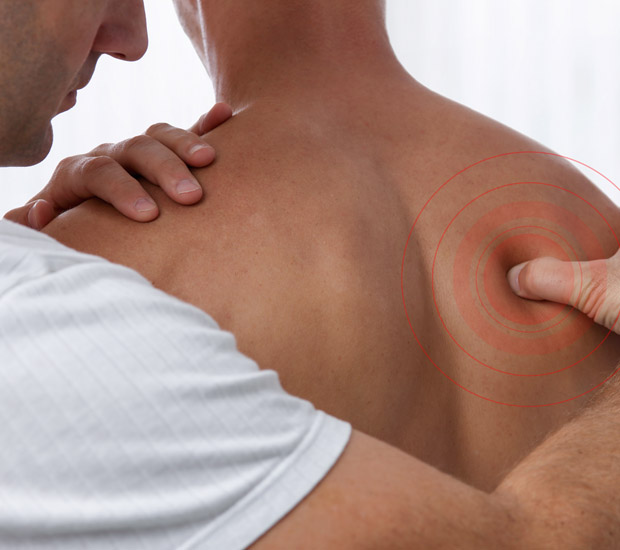Trigger Point TherapyTampa, FL
Trigger points are tender knots of muscle and tissue that develop from overuse, underuse, stress, or anxiety. Trigger point therapy applies pressure to a patient’s muscles to release these tissue knots and helps them relax to their natural state. Trigger points cause discomfort and pain and should not be left untreated. Fortunately, our team is here to help.
Our team at Body XI uses trigger point therapy to bring long-lasting pain relief to our clients. Learn how this approach to treating trigger points could help you feel like yourself again. Call our office at (813) 518-0566 to learn more or schedule an appointment.
What Are Trigger Points?
Trigger points (TrPs) are painful soft tissue knots within or near a strained muscle. They are the primary symptom of Myofascial pain syndrome. Myofascial pain syndrome sets off muscle trigger points brought on by overuse, underuse, injury trauma, stress, and anxiety. TrPs can be found on any part of the body but most commonly develop in the neck, shoulders, and back area.
Trigger points are painful and sore when touched and pressed, causing muscle fibers to shorten and tighten. There is also a reduction in blood flow that can cause more discomfort. The pain can even spread to other parts of the body. For example, if a patient has a trigger point in their shoulder, it can spread up their neck and cause a headache or migraine. This sensation is known as referred or reflective pain.
While some people learn to live with the pain, untreated trigger points can lead to further physical problems and increased discomfort. The longer a trigger point goes untreated, the more the tissue will continue to tighten. The weakening muscle can then prevent full strength and motion, creating an imbalance and higher chance of injury. In fact, trigger points can also cause sleep problems and worsen symptoms of fibromyalgia in some patients.
What is Trigger Point Therapy?
Trigger point therapy is a therapeutic technique that releases or softens a tightened muscle or a knot. This technique reduces or eliminates muscle pain, stiffness, and general discomfort from the knot. This therapy may also be called myofascial trigger point therapy or neuromuscular therapy.
Trigger point therapy aims to reduce or eliminate pain, increase range of motion and flexibility, and restore normal muscle function. It helps the muscle and surrounding tissue to relax and allows fresh blood flow to provide the affected area with nutrients, bringing the muscle back to a functional, healthy state. When a trigger point is released, and the muscle relaxes, it brings much-needed pain relief to the patient.
Types of Trigger Point Therapy
There are various techniques used in trigger point therapy. They can be used individually or in combination with different methods. Some of the most common approaches are:
- Myofascial Release: Myofascial release treats trigger points during a traditional massage therapy session. It works the surrounding muscles that might be causing the patient reflective pain to reduce tension throughout the body and entire muscular system.
- Dry needling: Dry needling targets specific myofascial trigger points or soft tissue and fascia. There are two types of dry needling: intramuscular stimulation (IMS) and superficial dry needling (SDN).
- Injections: Trigger point injections are a minimally invasive technique that injects small amounts of medicine into the problem area. The medicine may include a local anesthetic, corticosteroid, or Botox directly into the trigger point.
- Chiropractic Care: While chiropractic care is typically known for treatment for spinal and joint realignment, it can also treat muscle pain and tightness. During treatment, the chiropractor uses direct pressure on the trigger point, working in combination with acupuncture or dry needling.
Depending on the patient’s situation and their medical provider’s advice, they may need more than one approach to treat their TrPs. Patients should also ask their massage therapist or chiropractor about what relief may be best. Treatments may vary at the patient’s chosen location and what each massage therapist specializes in.
Benefits of Trigger Point Therapy
There are numerous benefits of trigger point therapy. It improves range of motion, flexibility, and posture while also relieving chronic pain symptoms. It can treat numerous conditions such as:
- Arthritis
- Chronic headaches or migraines
- Fibromyalgia
- Herniated discs
- Musculoskeletal pain
- Sciatica
- Temporomandibular joint dysfunction (TMJ)
Many patients who struggle with chronic pain may try non-invasive treatment options. Trigger point therapy has limited side effects depending on the treatment type. While dry needling is minimally invasive and some forms of massage therapy can cause soreness, the pain relief provided by these treatments is often seen as worth the temporary discomfort.
What to Expect and Aftercare
Before a trigger point therapy session, patients should drink plenty of water. A hydrated body can better process toxins released from trigger points. Patients should also wear something comfortable and easy to move around in. There may be multiple physical exams to show the massage therapist or chiropractor their mobility, flexibility, and any anatomical traits that may be contributing to the patient’s pain. Some providers may also require the patient to take a neurological exam, such as testing reflexes or responses to skin sensations, to determine if the pain is related to nerve damage.
The specific type of session and treatment depends on the trigger points' severity and location. The therapist may ask the patient to sit or lay down. The therapist will likely target muscles far from the original pain site to address what hurts and why it hurts. While some people may feel significant relief after the first session, others may need several treatments before the pain subsides. Continued treatment can help reduce the chances of trigger points developing as well as prevent future inflammation and discomfort.
After the session, the patient should continue to drink plenty of water. They may feel sore or tired as the muscle relaxes and returns to standard function. The improvement rate will depend on several criteria, such as their condition, general physicality, and any other pre-existing health conditions. Patients should minimize stress, participate in less strenuous activities, and avoid overexerting themselves.
Call us to learn more
Trigger points are a common cause of pain and can prevent people from living a full life. Don’t let trigger points go untreated. Body XI treats trigger points in Tampa and the surrounding area. Call us at (813) 518-0566 If you would like to learn more about our trigger point services or schedule a consultation.
Frequently Asked Questions
Is trigger point therapy painful?
Although trigger points are painful and hypersensitive, trigger point therapy should never be overwhelmingly painful. When receiving injections, some patients may have pain or temporary numbness and discoloration around the injection site, may be lightheaded or dizzy, and slight bleeding. Even if patients experience any discomfort during treatment, they can communicate with our team to change the level of pressure.
Is a therapy point therapy session the same as a body massage?
While some trigger point specialists are also certified massage therapists, there are several differences between the two services. Trigger point therapy focuses on treating knots of tissue and relieving pain. Massage therapy may release tension, but it has a broader mission of relieving tension and promoting relaxation.
What is the difference between dry needling and acupuncture?
There are some similarities between dry needling and acupuncture since they both involve needles to relieve pain. However, acupuncture has been around for centuries and is largely regulated. Dry needling is a newer and less researched method. Acupuncturists insert needles into different areas to stimulate energy flow throughout the body, while during dry needling, the practitioner – typically a sports or physician therapist – inserts short, thin, and stainless steel needles into specific trigger points.
Can I treat trigger points at home?
For less severe trigger points, it is possible to treat them at home with manual massage techniques and vibration massage from a hand-held massager. However, for more severe trigger points, it is recommended that the patient go to a professional and ask them about home methods they can do in combination with professional trigger point therapy. Trigger points often cause pain in different body parts outside the strained muscle. A professional would be able to treat the trigger point and the other painful sites better than an at-home treatment method.
How many sessions does it take to feel better?
Typically, patients feel significant relief after the first few sessions. However, each situation and patient is different, so the duration may vary. Key factors are how long the patient has been in pain, how severe the pain is, where the pain is, and the patient’s general health. The patient should also ask their therapist about how they can address perpetuating factors to help treatment be more effective, such as posture, sleep, and nutrition.





